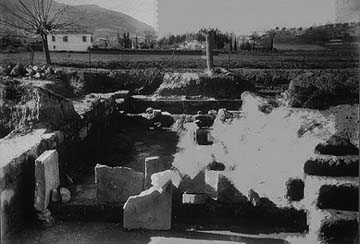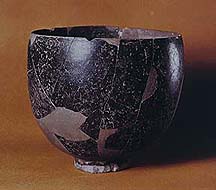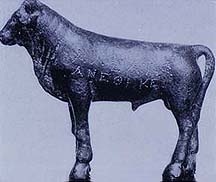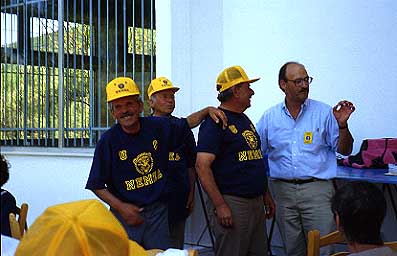 |
 |
 |
 |
 |
 |
 |
 |
 |
 |
 |
 |
 |
ANCIENT NEMEAHISTORY OF EXCAVATIONS AT NEMEA |
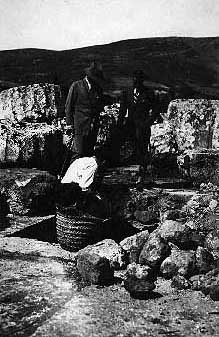
Bert Hodge Hill (left) and Carl W. Blegen supervise excavations in the cella of the Temple of Zeus in 1924. |
|
Richard Chandler writes of the visit to Nemea by the Society of the Dilettanti in 1766: "We pitched our tent within the cell (sic), on the clean and level area . . . . a road . . . turns to the right to a village called Hagio Georgio, or St. George, from whence we procured tools to dig, and wine, with other necessities." It may be supposed that the digging was in hope of finding sculpture from the pediment of the Temple of Zeus. Since, as we now know, the temple never had such decoration, we may assume that the Dilettanti left Nemea empty-handed.
During the next century Nemea was visited frequently, but no excavation work is recorded. Colonel William Leake's visit was perhaps the most significant, for he recognized the location of the Early Hellenistic Stadium. In 1883 a team of French engineers dug a new drainage channel (or "river") through the valley. During that work they cut through the sunken chamber of the Bath and other ancient levels west of the Temple of Zeus. The following year, in 1884, G. Cousin and F. Dürrbach of the French School of Archaeology carried out minor excavations at Nemea. Their work seems to have been limited to some clearing around the fallen columns of the Temple of Zeus which was not so extensive as to allow them to identify the sunken crypt at the rear of the cella. They also took apart the remains of a Byzantine chapel which overlay the Early Christian Basilica, and they published the fragmentary inscriptions that they recovered.
In 1924 a team from the University of Cincinnati led by Bert Hodge Hill and Carl W. Blegen, and under the aegis of the American School of Classical Studies at Athens , began the first of three successive years of excavation at Nemea. During those campaigns test trenches proved the identification of the stadium made more than a century earlier by Leake, the Early Christian Basilica was laid bare, and Oikos 1 and the Bath were discovered.
The prehistoric sites on the ridge of Tsougiza west of the Sanctuary of Zeus were also identified: a Mycenaean settlement on the crest, and an Early Neolithic refuse pit on the eastern slopes.
In 1927, the year after the American archaeologists left, a local farmer dug a well in the area of the kilns south of Oikos 6 and Oikos 7. He discovered a bronze bull
which had been dedicated to Zeus. The bull was illegally exported from Greece and is now in the museum of the University of Illinois. During the 1930's Hill continued his study of the temple, and carried out excavations within the Basilica although those were never reported. In 1962 and 1964, the American School returned to Nemea with Charles K. Williams, II, directing the excavations which were focussed on the final publication of Hill's work on the temple. Williams was successful in that goal, and also carried out excavations to the south that exposed parts of Oikos 2 and Oikos 3, the eastern end of the Xenon, and one of the kilns.
In 1973 the University of California at Berkeley, again under
the aegis of the American School of Classical Studies, began excavations
at Nemea that continue today. Stephen G. Miller has been the director
of this whole phase of the excavations which saw extensive large-scale
work from 1974-1983 and again since 1997, and smaller projects,
research, and publication in the intermediate years. Other aspects
of the project are the construction of the museum,
creation of archaeological parks at the Sanctuary
of Zeus and the
Early Hellenistic Stadium, reconstruction of the Temple
of Zeus, and the revival of the
Nemean Games. All of the work at Nemea is funded solely by private donations. If you would like to join in this effort, you can make a tax-deductible contribution in the form of a cheque payable to "The Regents of the University of California - Nemea", and send it to: Professor Stephen G. Miller, Department of Classics, MC
#2520, University of California, Berkeley, CA 94720-2520.
|
All materials from this site are copyrighted. Materials may be used with permission upon request.
This web site was designed and developed by Susannah L. Van Horn; please direct comments and inquiries to: nemeaucb@berkeley.edu
.jpg)
